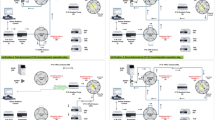Abstract
The goal of this work is to validate a quantitative method to analyze 15 triacylglycerols (TAG) which are present in cucurbitaceous oils using a new liquid chromatography-evaporative light-scattering detector (LC-ELSD) methodology. For the majority of the TAG, the absence of chromophoric groups absorbing in a spectral zone different from those of the high performance liquid chromatography mobile phases limits the use of UV detectors. The most convenient detectors for this type of analyses are the “universal” aerosol-based detectors, and the most frequently used one among these detectors is the ELSD. TAG responses using ELSD can vary according to their structure and the analyst may not possess all the 15 different TAG standards. Therefore, the determination of these analytes in unknown samples cannot be accurate and depends on the nature of the available standards. We propose here a new quantification methodology by LC-ELSD using the standard response model A = a × m b, where a and b are numerical coefficients which are specific for each solute and both correlated. The method uses a sample dilution procedure which provides for each compound to quantify an accurate b value, and by calculation, the corresponding a value. The quantification of both coefficients a and b easily gives the direct mass determination of each TAG. Such LC-ELSD results are validated by the comparison with the fatty acid methyl ester (FAME) analysis using the conventional capillary gas chromatography-flame ionization detector that transforms non-volatile TAG in FAME after a transesterification step. To perform this validation, we compared the experimental FAME composition to the theoretical one calculated from the TAG results obtained by LC-ELSD. For each TAG, theoretical and experimental values were statistically similar, which proves and validates the relevance of the new quantification methodology proposed in this work. The concordance between the two different methods also highlights the great advantage of the direct LC-ELSD method which additionally provides more information on TAG structures.



Similar content being viewed by others
References
Charlesworth JM (1978) Anal Chem 50:1414. doi:10.1021/ac50033a011
Dreux M, Lafosse M, Morin-Allory L (1996) LC-GC International 9:148
Dreux M, Heron S, Maloumbi MG, Tchapla A (2007) Brevet SEDERE S.A./Université d'Orléans UFR de sciences/Université Paris XI-IUT d'Orsay. 0752752, 1
Gaudin K, Baillet A, Chaminade P (2004) J Chromatogr A 1051:43. doi:10.1016/j.chroma.2004.05.021
Hazotte A, Libong D, Chaminade P (2007) J Chromatogr A 1140:131. doi:10.1016/j.chroma.2006.11.067
Heron S, Tchapla A (1994) in Fingerprints of triacylglycerols from oils and fats. Ed Sedere, Alfortville, France
Heron S, Bleton J, Tchapla A (1995) In: Sebedio JL, Perkins EG (eds) New trends in lipid and lipoprotein analyses. AOCS, Champaign Illinois, p 205
Heron S, Dreux M, Tchapla A (2007a) LC-GC Eur 21:414
Heron S, Maloumbi M-G, Dreux M, Verette E, Tchapla A (2007b) J Chromatogr A 1161:152. doi:10.1016/j.chroma.2007.05.101
Lisa M, Lynen F, Holcapek M, Sandra P (2007) J Chromatogr A 1176:135. doi:10.1016/j.chroma.2007.10.075
Lutzke BS, Braughler JM (1990) J Lipid Res 31:2127
Maloumbi MG, Dhellot J, Silou T, Tchapla A, Heron S (2008) OCL 15, 3, 213
Megoulas NC, Koupparis MA (2004) J Chromatogr A 1057:125. doi:10.1016/j.chroma.2004.09.052
Nikolova-Damyanova B (1997) In: Christie WW (ed) Advances in lipid methodology-four. The Oily Press, Dundee, p 193
Palmer AJ, Palmer FJ (1989) J Chromatogr A 465:369. doi:10.1016/S0021-9673(01)92674-3
Shukla VKS (1995) In: Sebedio JL, Perkins EG (eds) New trends in lipid and lipoprotein analyses. AOCS , Champaign IL, p 38
Silou T, Kinkela T, Heron S, Tchapla A (2006) La rivista italiana delle sostanze grasse LXXXIII, 129
Author information
Authors and Affiliations
Corresponding author
Rights and permissions
About this article
Cite this article
Heron, S., Maloumbi, M.G., Silou, T. et al. Calibration of an Evaporative Light-Scattering Detector for the Universal Quantitative Analyses in Liquid Chromatography—Application to the Determination of Triacylglycerols in Cucurbitaceous Oils. Food Anal. Methods 3, 67–74 (2010). https://doi.org/10.1007/s12161-009-9085-0
Received:
Accepted:
Published:
Issue Date:
DOI: https://doi.org/10.1007/s12161-009-9085-0




